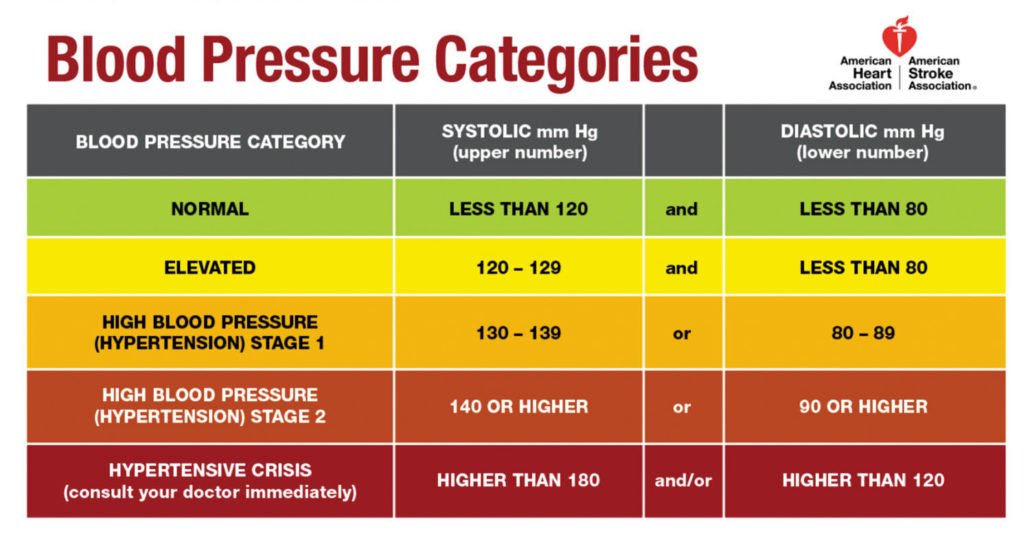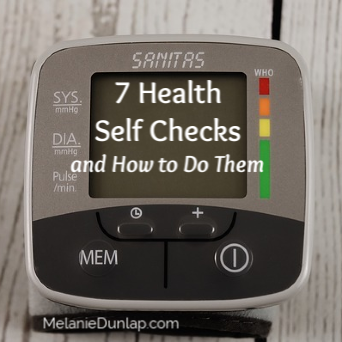Nobody knows your body better than you. You live in it every day. You are responsible for its care and maintenance.
Yet sometimes you forget to check it out.
Health self checks should be a part of your wellness routine. They are simple and you can do them at home.
Here are 7 health self checks that you should be doing:
HEART RATE CHECK
Each year 1 in 4 Americans die from heart disease. It is the leading cause of death for men and women. Monitoring your heart rate may help you spot developing health issues.
According to the American Heart Association your heart rate should be between 60 and 100 beats per minute.
The easiest place to find your pulse is in your wrist.
- Turn your hand so that your palm is facing up.
- Place the three middle fingers from your other hand over your wrist below the base of your thumb.
- Press down until you feel a pulse.
- Count the number of beats for 30 seconds and double that number to get your heart rate.
BLOOD PRESSURE
If you have high blood pressure, then hopefully you already check this one regularly. Known as “the silent killer”, high blood pressure has no symptoms until there is damage to the heart or arteries.
Normal blood pressure is at or below 120/80.
- Systolic: The top, higher number measures pressure in the arteries when the heart beats. It should be 120 or below.
- Diastolic: The bottom, lower number measures pressure in the arteries between beats. It should be 80 or below.

A home blood pressure monitor is a good investment. Make sure that it is accurate, and the cuff size fits your arm. Sit quietly while you take your blood pressure and rest your arm on a surface at heart level. Place the cuff on bare skin, not over clothing.
SKIN
One of the easiest health self checks you can do is to check your skin for new or changing conditions. Skin cancer is the most common type of cancer and you can see it without any special equipment.
Look for new or changing moles, blemishes or freckles. Examine all areas including your palms and soles of your feet, scalp, ears and your back.
The Centers for Disease Control recommends the A-B-C-D-Es of melanoma:
- A: stands for asymmetrical. Does the mole or spot have an irregular shape with two parts that look very different?
- B: stands for border. Is the border irregular or jagged?
- C: is for color. Is the color uneven?
- D: is for diameter. Is the mole or spot larger than the size of a pea?
- E: is for evolving. Has the mole or spot changed during the past few weeks or months?
Talk to your doctor if you notice changes in your skin such as a new growth, a sore that doesn’t heal, a change in an old growth or any of the ABCDEs of melanoma.
WAISTLINE
Measuring fat around the belly could be the most important health self check for men. Belly fat on men produces hormones that increase a man’s risk of heart disease, stroke and diabetes.
Ladies don’t put down the tape measure just yet. You also run the same risks if you have excessive fat around the belly.
Recommendations are for a waist of less than 40 inches for men and 35 inches for women. (this is my least favorite self check)
How to measure your waist circumference:
- Find the top of your hip bone and the bottom of your ribs.
- Breathe out normally.
- Place the tape measure midway between these points and wrap it around your waist. Don’t hold the tape too tight or loose.
HEIGHT
Chances are you haven’t paid much attention to your height since you were a kid growing up. As an adult over 50, measuring your height at least once a year is a simple way to self check how healthy your bones are.
A loss of height means that you are losing bone, an early sign of osteoporosis.
Keep your bones strong by getting enough calcium and weight-bearing exercise. All exercise is great, but you want exercise that will specifically help your bones like walking, running, jogging or lifting weights.
SELF BREAST EXAM
It was drilled into me as a young woman that I should be doing a breast self exam every month. Some doctors gave you step-by-step instructions printed on laminated cards that you could hang in the shower.
You might be surprised to hear that there is some disagreement in the cancer community over the recommendation for women to do self breast exams. Some studies have shown that it does not have a meaningful impact on survival rates and even may cause harm by prompting unnecessary biopsies.
The American Cancer Society no longer recommends breast self-exam as a screening tool for women with an average risk of breast cancer. They recommend screening mammograms starting at age 55.
While the arm over your head and circle your breast routine may not be recommended these days, women should still practice breast self checks. It is important that you are familiar with the normal look and feel of your own breasts.
- Stand with your upper body unclothed and look at your breasts in a mirror.
- Check your breasts and nipples for any discharge, puckering or retraction.
- Look for any asymmetry or skin changes in your breasts.
- Feel your breasts for any changes.
TESTICULAR
Okay guys this may be uncomfortable to talk about, but it is important. Testicular cancer is on the list of most “curable” cancers but 1 in 270 men will still get it. Like any cancer, the earlier you find it the better the prognosis is likely to be.
Sadly, men are not often encouraged by their doctors to do self checks. In fact, most men have never been told how to do it unless there is a family history.
The best time do a self check is in the shower when the skin of the scrotum is relaxed. To do a testicular self check:
- Hold your penis out of the way and check one testicle at a time.
- Hold the testicle between your thumbs and finger of both hands and roll it gently between your fingers.
- Look and feel for any hard lumps or smooth rounded bumps or any change in the size, shape or consistency of the testicles.
These are all simple health self checks that you can do at home. And after the initial purchase of a blood pressure monitor and tape measure, the rest is at no cost to you. Talk with your natural health professional about how often you should be doing each of these checks. Recommendations vary depending on your health history.
If you find anything unusual on your self checks report it to your doctor and follow up. With any kind of illness, the earlier we can do something about it, the easier it is to treat.
